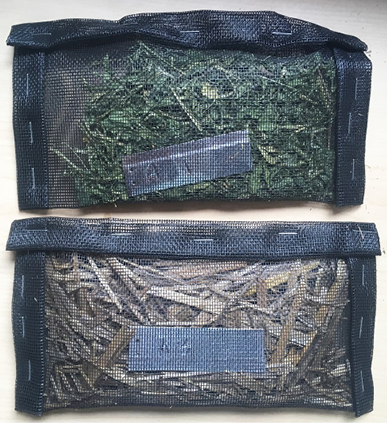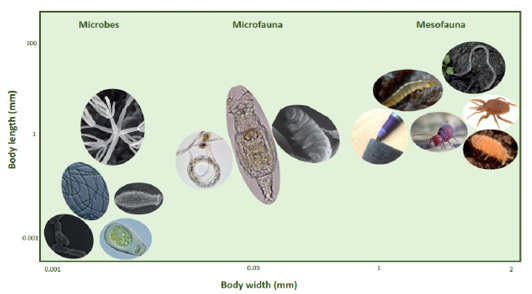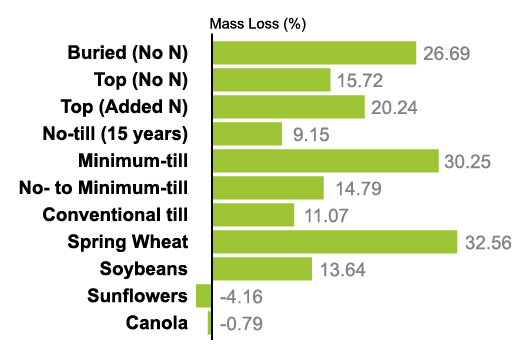Measuring Soil Microbial Activity by Using Litterbags (SF2022, June 2021)
Measuring decomposer communities directly in the soil requires specialized methods and it can be expensive. Instead of measuring the organisms, we can measure their activity through time, especially as it relates to breaking down old crop residues. We use litterbags to do this.
Litterbags are small mesh bags that are filled with a known quantity of litter (Figure 1). The bags are buried in the soil or placed on the soil surface for a specified time. The mesh allows microbes and small arthropods to break down the litter.
After a growing season, the litterbag is retrieved, cleaned and measured for how much litter disappeared through the actions of soil microbial activities. Litterbags offer an easy way to monitor the activity of a soil’s decomposer community.

- Figure 1. Two litterbags with measured quantities of spring-wheat and alfalfa litter. (Caley Gasch, NDSU)
Who is doing the work?
The mesh material used in this demonstration will allow entry by organisms that are smaller than 2 millimeters (mm). This includes the following groups (see Figure 2):
- Microbes: bacteria, archaea, fungi and protists. These are single-celled organisms or multicellular organisms that have a thin, threadlike growth form. Microbes are too small to see with the naked eye, but they are abundant in soil. They grow in and around organic matter, and they are important decomposers and nutrient cyclers.
- Microfauna: nematodes, rotifers and tardigrades. These are very small soil animals that are dependent on water films in soil because they live an aquatic lifestyle. They are also important decomposers, as well as microbial predators. Some of these are visible with the naked eye, but most microfauna viewing requires a microscope.
- Mesofauna: springtails, mites, pot worms and other small invertebrates. These are tiny arthropods and
small segmented worms that can be seen with the
naked eye. They are especially common in layers of
plant litter on the soil surface. They play important
roles in shredding and fragmenting litter or residue to speed up the decomposition process. They also prey
on smaller soil organisms and each other.
The mass loss reflected in this demonstration represents the decomposing activities of these organisms. The litterbags exclude larger, perhaps more familiar decomposers, such as beetles, termites, centipedes and millipedes, earthworms, slugs and many other soil-dwelling critters.

- Figure 2: Illustration of approximate and relative sizes of different soil organisms that can be involved in the decomposition of litter inside of our mesh litterbags. (all images from Orgiazzi et al., 2016)
Goal
The main goal of the litterbag demonstration is to bring awareness of the soil biosphere to producers. This is achieved by examining the approximate levels of microbial activities and their effects on plant production within different cropping systems and tillage/soil management practices.
Increased microbial activity requires an optimum carbon-to-nitrogen diet (C:N ratio), which generally ranges from 25 to 30 parts of carbon for each part of nitrogen. Because most annual crop litter, such as spring wheat, contains much higher carbon versus nitrogen (80 parts of carbon for each part of nitrogen), urea was used to add nitrogen to some litterbags at each site to bring the overall C:N ratios to 25:1 for optimum litter degradation.
Approach
Since 2019, the same six producers were contacted to participate in a litterbag demonstration project at eight sites scattered across Towner County. Out of the eight sites, one is no-till (15 years), one is minimum to no-till, four are minimal-till and two are conventionally tilled.
Crop rotations vary for each site. Considering the variability in crop rotations and annual weather changes, this is potentially a 10-year project.
At each site, three 6- by 10-inch mesh bags constructed of nylon fabric and filled with wheat straw are used as litterbags. The following placement approach has been adopted to account for microbial activity by measuring litter degradation:
- Before placement, the weight of wheat straw in each litterbag is measured in grams, which is considered as the “beginning weight.”
- Each year, litterbags are placed at all sites in one day, around June 20.
- At each site:
- The first litterbag is buried 2 inches below the surface without adding any nitrogen.
- The second litterbag is placed at the soil surface without adding any nitrogen.
- The third litterbag is placed at the soil surface with added nitrogen by adding urea.
- A tall flag is placed to mark the sites.
- Each year, litterbags are retrieved from each site on the same day, around Aug. 12.
For each litterbag, a fresh weight of litter in grams is measured shortly after collecting the bags from the field. Next, litter is washed, dried and weighed again. That is considered as the “end weight.” The “mass loss” is calculated in percent by first deducting the “end weight” from the “beginning weight” and then dividing that number with the “beginning weight” multiplied by 100.
Results
A higher loss in mass indicates higher microbial activity. Average 2019 and 2020 combined effects of litterbag placement, tillage practices and crops on mass loss (%) are presented in Figure 3.

- Figure 3. Average 2019 and 2020 combined effects of litterbag placement, tillage practices and crops on mass (%) loss.
Below are the key observations based on the results in Figure 3.
- The litterbags that were buried 2 inches in the soil had the highest mass loss followed by the litterbags that were left at the soil surface with added nitrogen. Bags that were left at the surface without adding any nitrogen had the least mass loss.
- Minimum-till tillage practices had the highest mass loss followed by no to minimum-till, conventional-till and no-till
(15 years). - Litterbags buried in spring wheat crops had the highest mass loss followed by soybeans. Litterbags that were buried in sunflowers and canola crops had a slight increase in mass, shown as negative values in Figure 3.
Things to Keep in Mind
- Many soil properties experience a delay in their responses to different management practices, including crop rotations. We observed higher mass loss under wheat crops, which might be a surprise because of wheat’s high C:N ratio. However, residual nitrogen (and mineralizable nitrogen) could be in the soil left over from the previous crop, which would have assisted in the litter decomposition during the wheat phase of the rotation. As this demonstration continues and trends become detectable, we hope to provide observations on crop rotation.
- What also may be a surprise is that the no-till samples had reduced mass loss, compared with the other tillage systems. No-till soils tend to store more nutrients (such as nitrogen) in organic matter and living biomass. As those nutrients are mineralized, they are taken up rapidly by plants and microbes. As a result, less free nitrogen is in the soil that can be used to aid in decomposing high-carbon materials (such as our litter). While the lower mass loss might seem like a problem, it indicates high nutrient use efficiency in those soils, good nutrient retention in the soil and less risk of nitrogen loss via leaching or volatilization.
- The litterbags exclude large insects and worms, which are also important decomposers who speed up the decomposition process. It isn’t meant to represent true rates of decomposition, but it does give us an indication of the activity of small soil organisms (microbes and small arthropods) and how they might differ across fields.
- Why do we have bags with negative mass loss? Roots, debris or soil may stick to the litter despite washing.
- This demonstration illustrates an easy approach for monitoring decomposition and soil biological activity; however, it is not replicated and is based on two years of data. We will continue this project for a few more years, and as the dataset grows, we’ll learn more and have more confidence in potential trends.
References
Bocock, K.L., and O.J W. Gilbert. “The Disappearance of Leaf Litter under Different Woodland Conditions.” Plant and Soil 9, no. 2 (Dec. 1, 1957): 179–85. doi:10.1007/BF01398924
Orgiazzi, A., et al. “The Global Soil Biodiversity Atlas.” European Commission. (2016) Available (free download) at www.globalsoilbiodiversity.org/atlas-introduction

